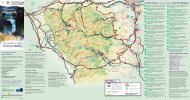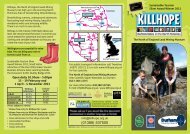How a visit to Killhope can inspire
How a visit to Killhope can inspire
How a visit to Killhope can inspire
Create successful ePaper yourself
Turn your PDF publications into a flip-book with our unique Google optimized e-Paper software.
UNIT 2B: PLANTS AND ANIMALS IN THE LOCAL ENVIRONMENT<br />
Using <strong>Killhope</strong>: <strong>Killhope</strong> provides a variety of contexts for the study of plants, animals and<br />
habitats. Our woodland contains a variety of wildlife: the squirrel hide provides a rare opportunity <strong>to</strong><br />
study red squirrels, birds at our bird feeders, rare black grouse, rabbits, and our reservoirs <strong>can</strong> be<br />
used <strong>to</strong> study pond ecology. We also have plants which grow on our Washing Floor, providing a<br />
suitable contrast <strong>to</strong> any other location.<br />
LEARNING OBJECTIVES POSSIBLE ACTIVITIES LEARNING OUTCOMES<br />
Looking for plants and animals<br />
• That there are different<br />
kinds of plants and<br />
animals in the immediate<br />
environment.<br />
• To treat animals and the<br />
environment with care<br />
and sensitivity.<br />
• To recognise hazards in<br />
working with soil.<br />
• To observe and make a<br />
record of animals and<br />
plants found.<br />
• That there are<br />
differences between<br />
local habitats.<br />
• To make predictions<br />
about the animals and<br />
plants found in different<br />
local habitats and <strong>to</strong><br />
investigate these.<br />
• To use drawings <strong>to</strong><br />
present results and<br />
make comparisons<br />
saying whether their<br />
predictions were<br />
supported.<br />
• Walk round the woods and the<br />
reservoir at <strong>Killhope</strong> <strong>to</strong> identify<br />
where plants are growing and<br />
where there are animals, eg<br />
under s<strong>to</strong>nes, or at our bird<br />
feeding area, or see the red<br />
squirrels. Help children record<br />
what they find.<br />
Describing local habitats<br />
• Chose two contrasting areas,<br />
such as the Washing Floor and<br />
the woodland and ask the<br />
children <strong>to</strong> predict what animals<br />
and plants they will find in each,<br />
and then <strong>to</strong> see what they find.<br />
Describe the differences<br />
between the areas.<br />
• Identify a number of<br />
plants and animals.<br />
• Produce a record<br />
showing clearly the<br />
living things they saw<br />
and where they were<br />
found.<br />
• Identify differences<br />
between two habitats and<br />
living things found there.<br />
• Suggests reasons for<br />
differences.<br />
38







